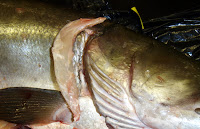Drs. John Casselman and Ed Crossman helped pioneer the use of muskellunge cleithrum bones to assess age and growth relationships across its distribution. This undertaking began in 1979 and is known to many as "The Cleithrum Project". Taxidermists probably contribute the largest number of cleithrum bones to the project, but anglers do as well after harvesting a fish or finding one dead. It is important information that can shed light on the potential maximum size or general growth rates a given body of water may have.
As part of the necropsy we performed last week, I was given a tutorial on cleithrum removal by (my partner in crime) Hedrik. He's well known within muskie circles, and perhaps to the chagrin of his partners (haha), for plunging his hands into a well decomposed, dry-heave-inducing dead muskie to remove its cleithrum bone for aging. I was excited to give it a shot!
Removing the bone is much easier than I expected, and becomes easier the longer the fish has been dead for. The procedure is simple: find the cleithrum bone at the edge of the gill opening, use your thumb to pry the bone loose from the connective tissue beginning from the bottom edge and moving towards the top, repeat until all connective tissue has been severed, pull the cleithrum down exposing the bottom/front tip, and continue pulling (if it does not come with relative ease some of the connective tissue may still be intact) until the bone lifts free from the flesh. Go slowly, if need be, to prevent breaking the bone.
For more pictures and more detailed step-by-step procedures visit: http://www.mnr.gov.on.ca/en/Business/LetsFish/2ColumnSubPage/STEL02_168800.html




Thanks for all the info I will tell this to my friends
ReplyDelete__________________
Emergency tree services Sydney